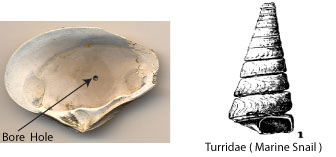Predation and Evolution:
Statistics demonstrate that Astarte and Anadara
evolve over time. Subsequent research by Dr. Kelley
explored what increasing shell thickness and internal volume might
represent, in terms of adaptation to an environmental stress. Her
work ("The effect of predation intensity on rate of evolution of five
Miocene bivalves," Historical Biology,
1991, vol. 5, pp. 65-78) suggests that changing shell thickness and
internal volume is a co-evolutionary process associated with predation
by Turridae
(marine snails). Through the preferential consumption by
boring snails of
thinner shelled
organisms (with less internal volume), thicker-shelled bivalves were
able to survive and reproduce. Over many generations, as more
thicker-shelled bivalves
reproduced, the entire population of Astarte and Anadara mollusks
within the Salisbury
Embayment were characterized by this increase in shell thickness and volume.

